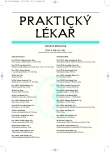Candida biofilms – a current problem of clinical practice
Authors:
E. Boroš 1; A. Jenča 2
Authors‘ workplace:
Oddelenie chirurgie, ŽNsP, Košice, Slovenská republika
Primár: MUDr. Erich Boroš
1; Klinika stomatológie a maxilofaciálnej chirurgie, LF UPJŠ, Košice, Slovenská republika
Prednosta: prof. MUDr. Andrej Jenča, CSc.
2
Published in:
Prakt. Lék. 2008; 88(12): 695-698
Category:
Reviews
Overview
Pathogenic species of the genus Candida are etiological agents of superficial and systemic diseases including nosocomial infections. Many Candida infections are associated with the production of biofilms on surfaces of medicinal implants. The biofilm is a microbially derived sessile community characterized by cells that are irreversibly attached to a substratum or interface or to each other, are embedded in a matrix of extracellular polymeric substances that they have produced, and exhibit an altered phenotype with respect to growth rate and gene transcription. Candida cells of the biofilms are resistant to a broad spectrum of antifungal substances commonly used in clinical practice. The current treatment is based on novel antifungal preparations with anti-biofilm action, for example lipid formulations of amphotericin B and echinocandins (caspofungin and micafungin).
Key words:
Candida, biofilm, resistance.
Sources
1. Calderone, R.A. Introduction and historical perspectives. In: Calderone, R. A. (Ed.), Candida and Candidiasis, Washington, DC, ASM Press, 2002, p. 3-13.
2. Donlan, R.M., Costerton, J.W. Biofilms: survival mechanisms of clinically relevant microorganisms. Clin. Microbiol. Rev., 2002, 15, 2, p. 167-193.
3. Dorko, E., Jenča, A., Pilipčinec, et al. Candida-associated denture stomatitis. Folia Microbiol., 2001, 46, 5, p. 443-446.
4. Dorko, E., Kmeťová, M., Marossy, A. et al. Non-albicans Candida species isolated from plastic devices. Mycopathologia 1999, 148, 3, p. 117-122.
5. Dorko, E., Kmeťová, M., Pilipčinec, E. et al. Rare non-albicans Candida species detected in different clinical diagnoses. Folia Microbiol. 2000, 45, 4, p. 364-368.
6. Dorko, E., Pilipčinec, E., Tkáčiková, Ľ. Candida species isolated from cerebrospinal fluid. Folia Microbiol. 2002a, 47, 2, p. 179-181.
7. Dorko, E., Pilipčinec, E., Tkáčiková, Ľ. Candidal urinary tract infections caused by non-albicans Candida species. Folia Microbiol. 2002b, 47, 2, p. 182-184.
8. Dorko, E., Pilipčinec, E., Tkáčiková, Ľ. Fungal diseases of the respiratory tract. Folia Microbiol. 2002c, 47, 3, p. 302-304.
9. Douglas, L.J. Medical importance of biofilms in Candida infections. Rev. Iberoam. Micol. 2002, 19, 3, p. 139-143.
10. Douglas, L.J. Candida biofilms and their role in infection. Trends Microbiol. 2003, 11, 1, p. 30-36.
11. Ghannoum, M.A., Abu Elteen, K.H. Pathogenicity determinants of Candida. Mycoses 1990, 33, 6, p. 265-282.
12. Hawser, S.P., Douglas, L.J. Resistance of Candida albicans biofilms to antifungal agents in vitro. Antimicrob. Agents Chemother., 1995, 39, 9, p. 2128-2131.
13. Henriques, M., Azeredo, J., Oliveira, R. Candida albicans and Candida dubliniensis: comparison of biofilm formation in terms of biomass and activity. Br. J. Biomed. Sci. 2006, 63, 1, p. 5-11.
14. Inabo, H.I. The significance of Candida infections of medical implants. Sci. Res. Essays 2006, 1, 1, p. 8-10.
15. Jabra-Rizk, M.A. Fungal infections and drug resistance. Emerg. Medical Crit. Care Rev. 2006, p. 1-7.
16. Jabra-Rizk, M.A., Falkler, W.A., Meiller, T.F. Fungal biofilms and drug resistance. Emerg. Infect. Dis. 2004, 10, 1, p. 14-19.
17. Kojic, E.M., Darouiche, R.O. Candida infections of medical devices. Clin. Microbiol. Rev. 2004, 17, 2, p. 255-267.
18. Kumamoto, C.A. Candida biofilms. Curr. Opin. Microbiol., 2002, 5, 6, p. 608-611.
19. Kumamoto, C.A., Vinces, M.D. Alternative Candida albicans lifestyles: growth on surfaces. Annu. Rev. Microbiol. 2005, 59, p. 113-133.
20. Laffey, S.F., Butler, G. Phenotype switching affects biofilm formation by Candida parapsilosis. Microbiology, 2005, 151, 4, p. 1073-1081.
21. Montero, A., Romero, J.A., Vargas, C.A. et al. Candida infection of cerebrospinal fluid shunt devices: Report of two cases and review of the literature. Acta Neurochir. 2000, 142, 1, p. 67-74.
22. Nett, J., Andes, D. Candida albicans biofilm development, modeling a host-pathogen interaction. Curr. Opin. Microbiol. 2006, 9, 4, p. 1-6.
23. Ramage, G., Saville, S.P., Thomas, D.P., López-Ribot, J.L. Candida biofilms: an update. Eukaryot. Cell 2005, 4, 4, p. 633-638.
24. Sullivan, D.J., Coleman, D.C. Candida dubliniensis: characteristics and identification. J. Clin. Microbiol. 1998, 36, 2, p. 329-334.
25. Tomšíková, A. Growing importance of non-Candida species as opportunistic pathogens. Folia Microbiol. 1997, 42, 6, p. 654.
26. Tomšíková, A. New yeast pathogens – agents of nosocomial mycoses. Folia Microbiol. 1999, 44, 1, p. 118.
27. Tronchin, G., Bouchara, J.P., Robert, R., Senet, J.M. Adherence of Candida albicans germ tube to plastic: ultrastructual and molecular studies of fibrilar adhesins. Infect. Immun. 1988, 56, 8, p. 1987-1993.
28. Van der Mei, H.C., Free, R.H., Elving, G.J. Effect of probiotic bacteria on prevalence of yeasts in oropharyngeal biofilms on silicon rubber voice prosthesis in vitro. J. Med. Microbiol. 2000, 49, 8, p. 713-718.
Labels
General practitioner for children and adolescents General practitioner for adultsArticle was published in
General Practitioner

2008 Issue 12
Most read in this issue
- Idiopathic thrombocytopenic purpura
- Percutaneous endoscopic gastrostomy – experience of one PEG centre in years 2002–2008
- Contemporary approaches to osteosynthesis of child fractures
- Sigmoid volvulus – untypical condition in childhood
